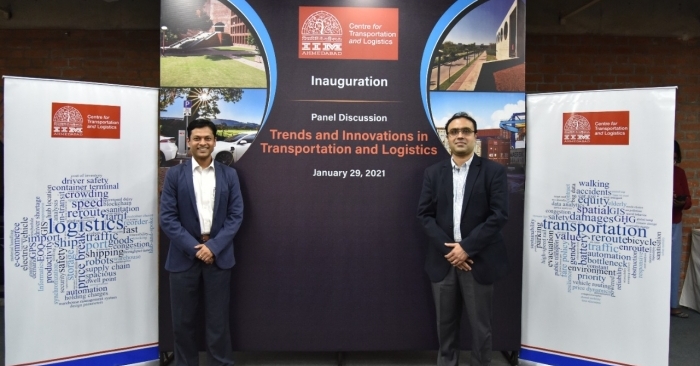11 major logistics, supply chain, e-commerce trends that will shape 2022
Professors Debjit Roy and Sandip Chakrabarti, who co-chair the IIMA Centre for Transportation and Logistics (CTL) speak to Lakshmi Ajay, ITLN, and make sense of the tectonic shifts taking place in the logistics and supply chain industry after a tumultuous year behind us.

January 17, 2022: What has the world learned from the jolts of the global supply chain disruptions that are affecting every industry. Can bringing in blockchain, IoT, and Analytics to supply chains bring in resiliencies and much-needed visibility to the sector? What is the environmental cost of these paradigm shifts? Professors Debjit Roy and Sandip Chakrabarti, who co-chair the IIMA Centre for Transportation and Logistics (CTL) speak to Lakshmi Ajay, ITLN, and make sense of the tectonic shifts taking place in the logistics and supply chain industry after a tumultuous year behind us.
1. China plus one strategy unlikely for now
Debjit Roy: China's expertise was not only low cost(manufacturing), but also seen in their whole infrastructure development. If we talk about the top 10 ports in the world, ten years back, it would probably be Rotterdam in Europe. And now they have moved to the ninth position because the first, second, third, fourth, fifth are all from Shanghai, China. So they have focussed not just on the labor cost, or the low-cost economy, but also on all the subsequent logistics infrastructure that makes them a superpower. So even if we want, we cannot stop China or avoid China. I think we will still be dependent on China as it takes time to build expertise as it doesn't happen overnight. We cannot avoid them overnight as it takes decades to build that kind of infrastructure. So it has to be phased out evenly and I don't think in a very immediate way we will be able to bypass them and they will be pretty much in the important supply chain.
Sandip Chakrabarti: In order to go beyond China, or beyond major hubs of manufacturing products, you're also asking for a radical change in consumer demand and consumer behavior. Sourcing locally, and all of that are great things on paper but it requires enduring, dramatic changes in consumer demand and behavior. Then the production side of manufacturing has to improve to match those levels that have already been established in China and in many other places. So can we force the consumer to change their habits, behaviors, and demands preferences? On the contrary, we can always say, why can't we develop better products in India, or build redundancies. And that gets us to the whole sort of geopolitical environment that produces certain kinds of locations that are specialists in cars, or where certain kinds of manufacturing and other things prosper. Businesses are attracted to certain places, because of the inherent advantages of certain places, not only the geographic advantages but also the political advantages, in terms of tax environments, political environments, compliances and you cannot change that.
2. Shift in manufacturing, supply chain strategy from ‘Just in Time’ to ‘Just in Case’
Debjit Roy: I think we used to always plan for ‘just in time’ earlier to reduce the inventory costs, but the paradigm is definitely shifting. People are moving towards ‘uncertainty planning’ now. For example, I know that people are sending their vessels or containers to two different routes so that the risk (of delay) is minimized. They are doing more ‘scenario planning’. Many companies I know are willing to have dormant warehouses, dormant capacity, more redundant capacity ‘just in case’. But while this will add to the cost, it gives them a huge advantage over the risk part of it. So now people have started building capacities because they do not know what's next. And once it is the next, then how do you really quickly react? So we did see some MoU’s, some tie-ups, some contracts in place for the ‘just in case’ scenarios.
Sandip Chakrabarti: We also need to analyze the effect of the ‘Just in case’ strategy on the environment. While we are going to be better at analyzing risk and in building the systems in supply chains or on the capacity side - this is also going to be an increased cost. But it could also increase the carbon footprint of operations. 'Just in case' could also mean stocking up even more which will lead to a lot of other problems. That increases cost, but it will also have a non-zero impact on the environment and that also needs to be looked at by scholars that are interested in studying it.
3. Digitisation, automation & robotics are here to stay
Debjit Roy: Digitisation and automation will not just reduce risk but will aid the speed part of it. So if you have these digital capabilities and it increases speed per second, you would also need to be flexible as nobody likes to have rigid automation but more flexible automation. So Blinkit (Grofers) has changed their business model 5-6 times in the last 7-8, as their business is moving very fast. More recently they changed their business model again with Blinkit saying that it will only target those customers who want 10 minutes delivery, so they left out about 180 million of the customers left. As they're moving, and changing the business model frequently, can they get into this rigid automation? Probably not. They want automation because they want to provide 10 minutes support, but then the backend should also respond to the admin support and so automation is the key. But then it will be useful to see what kind of automation is needed and how flexible it is in handling product variety and also managing the high and the low volumes.
Sandip Chakrabarti: An example is how in the Volkswagen manufacturing plant, they use the same robotic arms to build and support many different brands. The same production line produces cars perhaps of different brands and variants of the same car as well. So this level of flexibility they have built-in is amazing as it doesn't matter if the demand side for certain brands and certain variants of brand fluctuates. Then they can use the same capacity, the same product inside of the same robots regardless of what the demand side is. So then no production line will remain empty, regardless of the fluctuations in demand.

Professor Debjit Roy, IIM Ahmedabad
4. Repurposing supply chains, manpower for resilience
Sandip Chakrabarti: We recently wrote about how certain kinds of manufacturing facilities are being repurposed for vaccines for example, which is a major repurposing. But think about the same plant being used for many different kinds of products, depending upon the need. So can the same kinds of plants that were producing a different product be repurposed flexibly using the same kinds of infrastructure that was there to produce a different kind of a product on the demand of the time.
Debjit Roy: Many bottling lines of mineral water plants did that to make sanitisers during the pandemic. Mahindra repurposed one of their assembly lines to make ventilators. During the pandemic, there were suddenly no jobs in restaurants. So many of the people who used to be chefs and others were required in hospitals. So it's not only about flexibility in machines, but also in humans, that is required everywhere. The most industry resiliency I have seen is in the e-commerce space. When the first national lockdown in India started, all the drivers became useless, because nobody wanted to use the passenger cars anymore. But then they repurposed some of those drivers for cargo delivery. Likewise, tech platform Dineout which introduced people to dining out options also repurposed their business model. During the 24 months of the pandemic, they actively engaged with their consumers, acquired several other brands like event and experience curator SteppinOut and expanded their product offering.
5. Digitisation can give more visibility to logistics supply chains
Debjit Roy: Not only private companies but India is also going in a big way towards digitizing logistics information. Through the mandate in PM Gati Shakti, they are trying to map all the logistics assets in one digital map, including both government as well as private ones. These help in multiple ways because it not only gives an opportunity to find out what are the good areas of investment, good locations of investment, but also it reduces the turnaround time to build new infrastructure, get approvals for new processes, and so on and so forth. Now they're trying to map infrastructure and all modes of transport also which will be linked to for example to the Ministry of shipping which will be having all the shipping assets linked to it and similarly with the railways, road transportation, and air cargo side. The idea is that everything is integrated and there is a move towards multimodal transport. The government is also giving a huge push towards logistics parks. Once you have these assets then, integrating these assets within a multimodal system will be useful. Again, for that the bottleneck today is the information. We don't have all the information on one portal? So hopefully Gati Shakti and other schemes would take out information silos.
6. Data is critical for shock proofing supply chains
Sandip Chakrabarti: During the pandemic, governments across all states, categorically allowed e-grocers players to operate. One of the biggest hurdles for them was policy uncertainty. A business did not know what kinds of formalities are required for interstate movement of goods. There was no portal, no information, nobody knew what State B needed in terms of approvals, in order for them to cross the border. That was the state of data sharing in our country, which is unfortunate because this is an essential service. So that is the importance of data, clarity, and certainty, as that is essential if we have to move to these kinds of resilient systems and transition to ‘just in case’. So data is critical and hopefully, Gati Shakti is going to bring all that data under a single platform where everybody can see it.

Professor Sandip Chakrabarti, IIM Ahmedabad
Debjit Roy: Data silos also create delays in the ports for example when visibility on the overall supply chain was missing. Containers do not know where they are going on their forward journey. It also creates inefficiencies within this port facility also because of multiple handling and pre-marshalling of containers. So this is a big challenge that happens when you do not have the advance demand information. There is a lot of talk about blockchain these days. Again it is still at the concept level and not much implemented yet.
7. Going sustainable is the best investment against risk
Sandip Chakrabarti: The importance of ESG is growing and companies are becoming responsible, which is pushing them to find ways including in supply chains, in choosing logistics in order to reduce their carbon footprint. Now, companies have started thinking about not only their own operations but further up and down the (supply) chain and going forward with life cycle assessments of their carbon impact. And a critical component of that is logistics. Who do you source from, but also what kinds of transportation modes you use, would have a huge impact on the company's carbon footprint? And because those have to be disclosed through the carbon disclosure project etc, companies are getting more responsible. We know that there is a move towards getting more responsible because consumers are watching, but also because investors are watching. Investors are also wanting to minimize the risk and so there is a natural move towards shifting or finding ways to reduce.
8. Mundane tasks will be done by robots, who will work in collaboration with humans
Debjit Roy: Maybe after 30-40 years all the mundane tasks will be replaced by robots. In Shanghai you already have small robots delivering food to homes, in the Rotterdam School of Management, Netherlands campus, they have robots delivering groceries to students. So this is happening everywhere, especially in southeast Asia. Mundane work will be replaced by more robots and more skillful work where there's some kind of intelligence involved, that will be taken up by humans. And it will not be either humans or robots, they will always work in collaboration. That's where the future is heading towards. Because even within the warehouse, a lot of work like traveling from point A to point B can easily be done by robots. What is not done is how well they can grasp a regular object, how much pressure to apply on all those things? So that work will still be done by human beings, but then certain work will be transmitted back to the robots. So there is a move towards collaboration and every industry is thinking about that and maybe some pilots are underway in many places already.
9. AI set to change the way we buy
Sandip Chakrabarti: In Seattle, a leading American retail brand, lets you try out certain garments through a mobile van and this initiative was AI-based. So what they did is, depending on what consumers were searching on their platform in a particular neighbourhood, they would send emails to those people in a local locality, that, hey, we are going to bring a cart, a bus, with a changing room and stuff to your neighbourhood on a Sunday afternoon, do visit us. So they tried this pilot. This way, they're bringing in that convenience that you don't have to come to us, we are going to come to you with exactly the thing you need, with exactly the thing that you need for you to try out and that's the future of E-commerce in some ways.
10. Logistics 4.0: variety, speed, convenience in e-commerce is here to stay
Debjit Roy: I think the variety element is always here to stay and convenience will go higher in e-commerce. Companies are also trying today to optimize the whole network itself. So the inventory cost comes down, the products which are not as present in some geographies will also get stocked over there. They are trying to also use the customer's shopping behaviour, their preferences, and the company’s own level to optimize the inventories and reduce the cost. At the same time, they're trying to set up a lot of small dark stores just like what Blinkit did. They have 300 plus dark stores that offer 10 minutes deliveries. So those will be mushrooming a lot more now. A trend that you will observe is speed, reliability, cost reduction, and more flexibility. They are trying to reduce the cost at the same time they're trying to also increase the speed and push the efficiency frontier altogether, with new business models. Swiggy’s Instamart is an example of this new business model which was not there before. So cost is decreasing, speed is improving, flexibility is improving and convenience is getting better. Automation is picking up to ensure that both the front end and back end work well to deliver in under 10-15 minutes and so you have to replenish the dark stores in an automated mode.
11. Move towards sustainability in post-pandemic retail
Sandip Chakrabarti: Companies would also probably lean ‘more responsibly’ going forward. Patagonia, for example, is a brand that sells winter and outdoor garments and has been promoting sustainable responsible practices. So for example, they will put big ads on the front page of major newspapers saying don't buy our stuff. They were among the first to promote the recycling of their jackets. So what became fashionable is worn-out clothes and in this instance worn-out Patagonia jackets became fashionable. What happened as a consequence is that their sales soared. And then people started saying that this is a kind of greenwashing. But then a careful analysis showed that the business proposition is that how can we become more responsible, by influencing the customer by at least telling them that buy what you need, be more conscious. So many businesses would probably be moving in that direction also. An example from a different field, for example, now, when you open an Uber app in Delhi or Hyderabad and look to go from point A to B, Uber shows not only the taxi services but also that you can take a metro or an autorickshaw on the same route so that you can make a decision. It knows that it is important in order to survive in an Indian context and for the government to recognize it as a key mobility player, and not just a service provider. But then there are other business motives also. But the idea is that companies will start showing that they are more responsible, but to their advantage, but hopefully begin considering environmental issues. This is a complex kind of marketing, but the basic idea or premise will be to reduce, repair, reuse and recycle.

Lakshmi Ajay
Associate Editor, STAT Media Group. She has previously worked with Ahmedabad Mirror, The Indian Express, Business Standard and The Times of India. Lakshmi can be reached at lakshmi@statmediagroup.com


